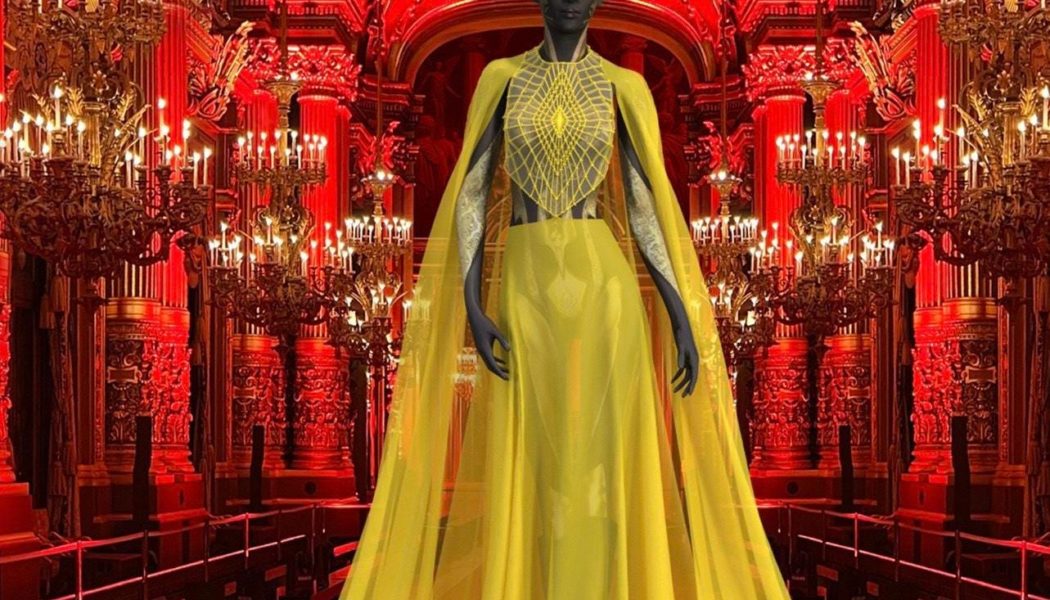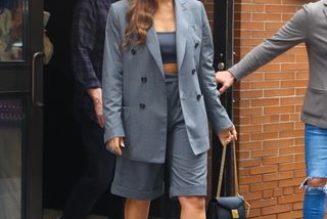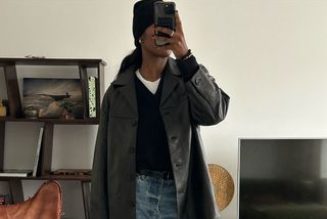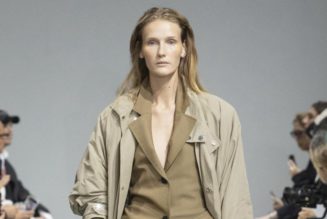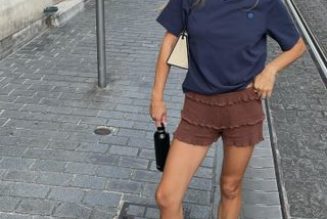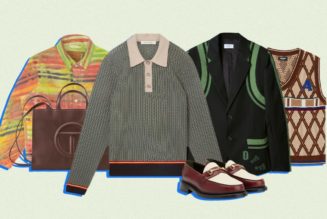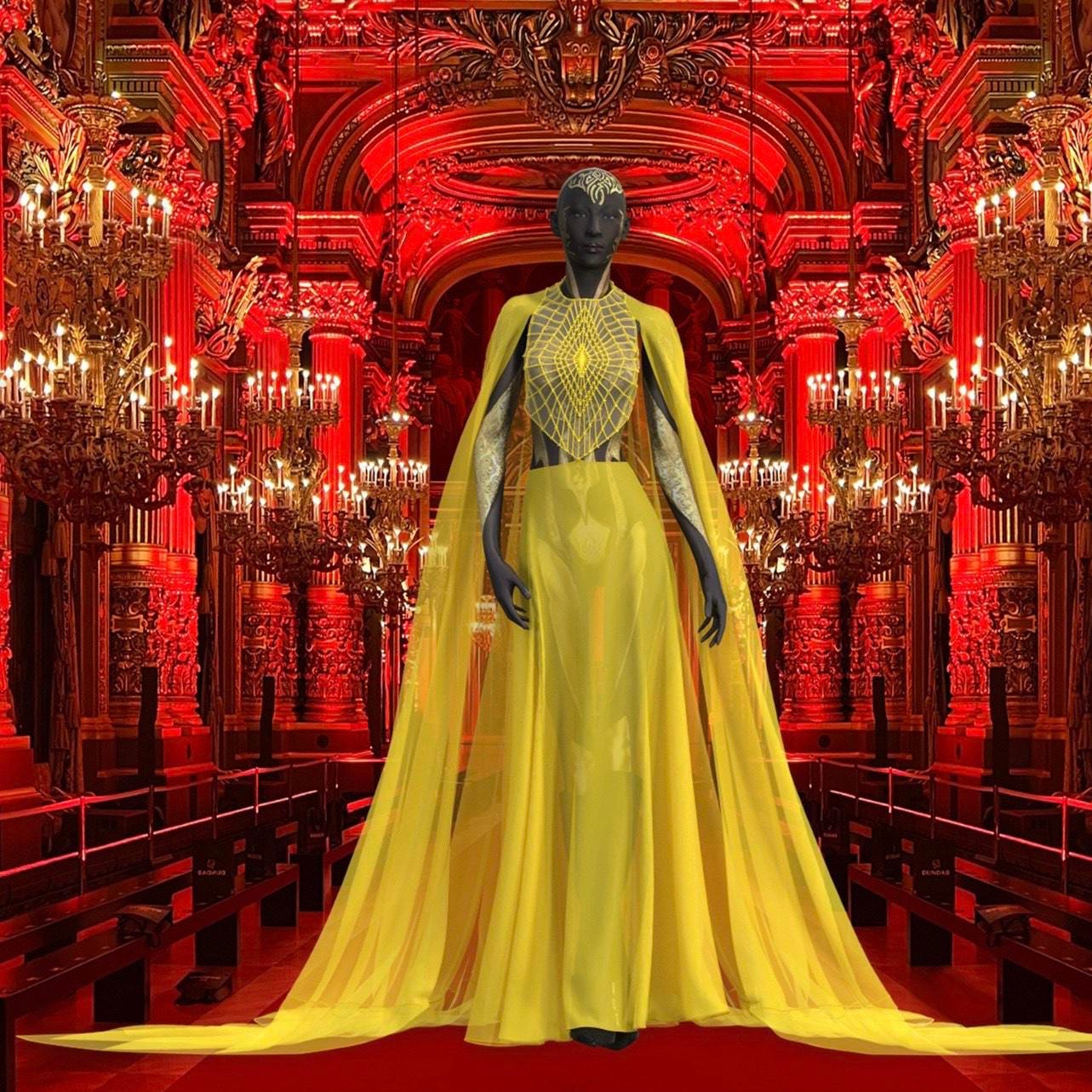
Crypto may be struggling to emerge from winter, but at Decentraland’s second annual Fashion Week avatars are downloading digital swag and emoting the night away like it’s 2021.
By Maria Gracia Santillana Linares and Nina Bambysheva, Forbes Staff
Standing next to the X-shaped runway in Decentraland’s second annual four-day Fashion Week, an attendee whose head is a large taco is partially obstructing the view of Norwegian designer Peter Dundas’ latest Beyonce-ready creation, as a virtual fashion model reminiscent of Grace Jones struts across the runway, occasionally leaping into flight to strike a pose.
No problem, simply walk through Mr. Taco, and past another avatar wearing pink neon “zzzz” glasses brandishing a giant marijuana leaf behind him and another in a traditional Korean Hanbok, to get an unobstructed stage front view. Instead of gawking at celebrities, the way one might at the real fashion week in Paris or Milan, the biggest challenge of attending a runway show in this Ethereum blockchain-based metaverse, is trying not to be distracted by the creative and sometimes bizarre outfits being worn by fellow attendees.
Fashion Week in Decentraland’s metaverse is a colorful hodgepodge of corporate branding, NFT collecting and virtual networking set in a sometimes glitchy video game environment. Getting around is as easy as teleporting between pavilions and after a runway show for a digital collective like the Haus of Fuego, or perhaps a sweat-free yoga session hosted by Alo, your avatar can “emote” the night away at virtual raves operating across different time zones, from Berlin to LA.
The 2023 event, which was held in late March, featured 63 different fashion houses, both established and “neo” including Adidas, Coach, DKNY, House of Barth, Tommy Hilfiger, Julia Blanc, Xiaoling Ji, and Dolce & Gabbana. The name of the game is branding and so-called digital wearables are being hawked throughout the environment. Dundas, for example, is selling 10 “looks” from its Paris fashion week, like a limited edition NFT of its double breasted navy blue “Jones Coat” which can be sent to your metamask wallet for 0.033 ETH, or about $60.
Digital-fashion, which has long existed in video games, amounted to an estimated $498 million in 2021. However as users flock to metaverses so will retailers and fashion houses. According to Allied Market Research the industry is predicted to grow into a $4.8 billion market by 2031,
“We’ve seen a lot of designers sort of dabble in this space and really started to experiment,” says Daniel Drak, assistant professor of strategic design and fashion communication at the Parsons School of Design. “But is that a really big opportunity for those brands to really make a ton of profit? I’d say no.”
The organizers, Decentraland and immersive culture platform UNXD, say the event is not just an online extravaganza for clothing companies and crypto geeks chasing new 3D sneakers and sunglasses, but also an opportunity to contemplate the future of digital wearables and fashion in general.
“In the same way that fashion might work in the real world, where if we put on amazing garments, a dress or a shirt we feel empowered,” Drak explains. “A lot of that also happens online.”
Plus, the entire luxury shopping experience gets less intimidating when the stakes are limited. Can’t afford Gucci? “Log into a metaverse platform and interact with the brand in some other way,” he says.
Decentraland uses Ethereum to record the ownership and transactions of those items, but mere presence in its virtual world and other data is not stored on the blockchain. The event took place in two of Decentraland’s 39 districts as users navigated or teleported around the event by clicking on the Fashion Week map.
“This year we decided to have a theme [called Future Heritage] to drive the discussion to a place of not just games and fun but to a place provoking thoughts,” says Giovanna Graziosi Casimiro, head of Metaverse Fashion Week (MVFW) at Decentraland. “The legacy of fashion is key for us to view its future so we are providing a space for different generations to discuss what is coming next.”
Connections among multiple metaverse platforms are an important part of that discourse. Decentraland partnered with 3-D metaverse Spatial and augmented reality metaverse Over to enable users at this year’s show to view and transfer digital wearables across platforms.
But for Fashion Week companies, ultimately it’s about financial opportunities. “Whatever you do in virtual spaces has to be somehow connected or have a return on investment for brands in the physical world,” Casimiro says.
For the 63 companies who applied and were granted the right to display their digital wearables in Decentraland’s Fashion Week 2023, attendance has been disappointing—approximately less than 50,000 users visited the event compared to roughly 70 brands and 108,000 visitors a year ago. Crypto’s winter has meant hard times in the nascent metaverse. Meta has reportedly downsized its Horizon Worlds division after its Reality Lab lost $13.7 billion in 2022, and Disney fired all its metaverse staff in its latest round of layoffs earlier this month. Moreover, virtual worlds experienced a significant decline in digital land trading volume over the past year, dropping to $311 million so far in the first quarter of 2023 from $688 million in Q1 2022, according to industry tracker DappRadar.
Additionally, NFT trading volume for fashion collections amounted to just $15 million in Q1 2023, a decline of 88% from the comparable quarter last year, which was dominated by Nike and Adidas at a combined 85% of sales. The target audience, tech-savvy Gen Zers sensitive to developments in the cryptocurrency sphere, may have been spooked by the recent spate of high-profile bankruptcies and a broad regulatory crackdown on digital assets in the U.S. Leading metaverse tokens like Decentraland’s mana and the Sandbox’s sand are down more than 70% over the past year.
Attendees gathered at the main runway for morning meditation and yoga hosted by Alo, practicing breathwork and even some downward dogs without breaking a sweat. But overall Fashion Week attendance down sharply from 2022.
The Decentraland Foundation
If the macro environment weren’t challenging enough, there are also nagging technical problems. An afternoon at Decentraland’s Fashion Week is a far cry from a trip to Milan’s Villa Carlotta during Italy’s real fashion week. Slow processing may be the biggest concern. Look too closely and you can see blurry pixelated brand names etched onto the floor of each exhibit. Move too fast through the platform and risk overtaxing the server, leading to skipped frames and randomly appearing buildings that can leave you feeling queasy. Scroll too fast and the browser freezes as it suffers exhibit overload, forcing you to reload your browser and start from the welcome area again.
Casimiro says Decentraland has tried to address technical issues and notes that it introduced new features such as credit-card payments, tools for garment creation and allowing brands to rent virtual land for specific periods rather than buy it.
Despite the challenges facing brands in metaverse environments like Decentraland’s Fashion Week, retailers and fashion are committed to investing in this new marketing frontier.
Adidas has a collection of 30,000 digital wearables built on Ethereum, which has had a trading volume of $138.6 million in primary and secondary sales since launching in December 2021. At Decentraland’s Fashion Week the sportswear giant created a 16-piece collection of virtual hoodies with prices ranging from $35 to over $8,000 for a pink hoodie launched in collaboration with Bored Ape Yacht Club, which features several columns of green eyes lining the pink-haired hoodie, mimicking the Adidas stripes.
“There are people who are collectors of culture, and they recognize that this is a really lightning rod moment in time, it’s a paradigm shift. That’s how I really think about who our holders are and who we designed it for,” says Erika Wykes-Sneyd, VP of Adidas Three Stripes Studio.
Italian luxury fashion house Dolce & Gabbana hosted its “Future Rewind” contest during the week, displaying winning designs for virtual pieces available exclusively to holders of DGFamily NFTs, a series of loyalty pieces. The American classic Tommy Hilfiger hosted an artificial intelligence competition, where winning preppy looks created by Irina Raicu and Alexandra Serban, were produced by digital fashion house Dress X as digital fashion collectibles.
Fashion statements weren’t limited to the runways as Decentraland’s denizens donned their party-best digital wearables.
Decentraland
Peter Dundas’ designs have graced some of the most well-known stages in pop culture – the Grammys stage, two Super Bowls and countless red carpets. Known for glitzy embellishments, metallic fabrics and deep cutouts in flowing gowns, the relatively new fashion brand marks quite a difference from the sporty pieces of Adidas and Hilfiger found in Decentraland.
“Because we’re not part of these huge brands,” says Evangelo Bousis, cofounder and image director for Dundas, “we allow ourselves the space and the time to actually do things that we really like.”
In partnership with Dress X, Dundas brought his special-occasion wear onto the metaverse, and by the end of the show nine of its 45 digital wearables were sold worth an estimated $666.
But it’s not just digital wearables on sale, some like yoga clothier, Alo, which joined the Metaverse Fashion Week roster this year as the official wellness partner, encouraged visitors to buy its real life bucket hats and sweat suits, available on their website for prices ranging from $58 to $138. At the start of the event, 72 million user avatars had already attended its yoga meditation and breath work, says global head of marketing Angelic Vendette.
“Folks are certainly leaning into their digital identity by showing up and showing that they have wellness and mindful movement at heart by wearing Alo,” in both the metaverse and real life. Alo sold out its bucket hats and unisex sweat suit pieces in stores and it attributes the spike in sales to its metaverse marketing.
“There has been a correlation, which has been really interesting to see,” says Vendette.
Dundas, on the other hand, has notched only a few real world sales emanating from metaverse efforts. Exploration of the field is still largely a marketing expense, says image director Bousis, as the brand has a “very small” budget for the collection amid a revenue-sharing contract with partners.
In its 2022 appearance in Metaverse Fashion Week, the brand made only three or four real world clothing sales, he adds, with items priced between $800 and $900 a piece.
It’s a long game. “We believe that in five to 10 years, people will all have digital closets,” says Bousis.
